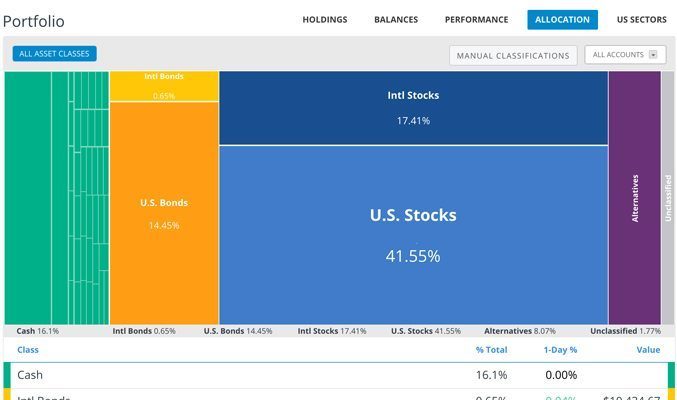Many people have asked me to write a post about roboadvisors. Before pulling together this post, I hadn’t spent much time reviewing the roboadvisors because it didn’t seem like they were offering much to a do-it-yourself investor such as myself. However, I recognize that not everyone wants to be involved in the nitty gritty of managing their own investments. Are roboadvisors a good idea for those people? You need to be aware that in putting together this article I entered into affiliate agreements with some of these companies, so if you decide to open an account using links on this page, the site could make some money.
What is a Roboadvisor?
In case you’re not familiar with the term, roboadvisors are part of a new wave of FinTech companies that offer a computer-based and automated service which provides a variety of investment advisory management and services for a fee. Thanks to their automated nature, roboadvisors charge substantially less in fees than a traditional financial advisor. Additionally, roboadvisors will work with you when you have a small account balance unlike some financial advisors that want to see $100,000 in the bank before they’ll even begin to talk to you.
Pros and cons of Roboadvisors
Let’s start with the cons. There are a few main reasons I’ve never invested money with a roboadvisor:
- Managing Investments Is Easy. Distinct from providing investment advice, the day-to-day management of investment accounts isn’t really that hard. There’s very little to do and rebalancing your accounts on an annual or semi-annual basis isn’t likely to take up much of your time. In fact, managing an investment account is substantially easier than just about every other financial aspect of my life, such as understanding PSLF, estate planning, disability insurance, figuring out which retirement accounts to use, etc.
- Very Little Financial Advice. There’s only so much financial advice a robot or platform can give you. For the roboadvisors, this is usually limited to providing a suggested asset allocation based on your savings goal or risk assessment. These types of asset allocations are helpful but can’t be a substitute for doing the work yourself to understand your true risk profile.
- Fees. Roboadvisors cost money. Even if the fee is only 0.3%, that fee comes directly out of your returns. A lawyer investing $50,000 a year for 30 years earning 8% interest will end up with nearly 6% more money than a lawyer investing the same amount but earning 7.70% interest ($5.66 million vs $5.36 million). That means the do-it-yourself investor will also end up with retirement income that’s 6% higher.
- Tax-Loss Harvesting. If you have a roboadvisor that’s performing tax-loss harvesting for you, forget about trying to do any tax-loss harvesting yourself in a separate account. Unless you are investing in completely different funds, it’ll be impossible for you to keep up with the transactions to avoid the wash-sale rules. And speaking of wash-sale rules, if your roboadvisor is tax-loss harvesting in a taxable account while you are making regular contributions to a retirement account, you’re also likely running afoul of the wash-sale rules if your retirement account contains the same funds that are being tax-loss harvested by the roboadvisor.
- Fee vs Services. At the end of the day, the question always comes down to whether the service is worth the fees. Only you can determine this, since it’s your money that’s being spent on the roboadvisory services. Based on my review, you could do a lot worse than a roboadvisor.
If you’re not convinced that you should handle your investments yourself, there are some real benefits to using a roboadvisor that may outweigh the bad. Here’s some of the good things:
- Automated Management. The roboadvisors are providing a service. It mainly consists of asset allocation, tax-loss harvesting, portfolio design and automatic rebalancing. Even if you could perform these tasks yourself, lawyers are a busy bunch and a roboadvisor will handle it automatically for you. Further, by letting a roboadvisor handle this automatically you’ll reduce your own desire to fidget with the account and numbers. Set it and forget it.
- Decent Portfolios. Roboadvisor portfolios are actually pretty sophisticated. They generally purchase broad index funds from low-fee providers such as Vanguard. You could do a lot worse than use a roboadvisor’s portfolio. While relying on a roboadvisor’s portfolio isn’t an excuse for understanding the underlying investments, I’m reasonably confident that you’ll be presented with good choices if you use a roboadvisor.
- Low Fees and Low Account Balances. Sometimes just getting started is the hardest part of investing. Roboadvisors charge low fees and most will let you open an account with barely any money. Paying a 0.3% fee on a $10,000 balance amounts to only $30 a year. Nobody has gone broke paying a $30 annual fee and if a roboadvisor is the gateway for you to get started with a taxable account and to learn about investing, it’s a great start. The problem is likely to come in the future when you’re still using a roboadvisor after having built up a six figure investment account but even then you may decide that the service is worth the fees.
- Roboadvisors are Legit. As the roboadvisor movement has grown, the big names have all joined the club and you can now find roboadvisors with Schwab, Vanguard, etc. It’s pretty clear that the roboadvisors aren’t commissioned salesmen and that they have only relatively minor conflicts of interest. Roboadvisors aren’t going to disappear like a Bernie Madoff with your money and in fact are likely to be around much longer than your parent’s financial advisor that is offering to help manage your money.
Overview of Roboadvisors
There’s quite a few roboadvisors in the market today and it’s easy to see why. Given that the process is completely automated, these companies can deploy a tech force to build the backend and then rely on a small sales force to grow the overall balance of the assets under management. When picking a roboadvisor, the same principles apply that you’d use to select any type of financial advisor: (1) calculate the costs and decide if the service is worth the fees; (2) understand what type of advisory services are offered; (3) can you talk to a live person if needed; (4) the online interface/technology; (5) the additional benefits, such as access to model portfolios, tax-loss harvesting, automatic asset allocation rebalancing, etc.
Wealthfront

Wealthfront and Betterment are the two “big” roboadvisors battling it out in the marketplace to manageyour money. For small accounts, it’s harder to do better than Wealthfront since it’s completely free for any accounts less than $10,000. For accounts greater than $10,000, Wealthfront charges a flat 0.25% annual advisor fee. Keep in mind that this fee is on top of the fees charged by the ETFs you will own (which Wealthfront estimates will be about 0.12%).
So what services do you get for your money? You’ll get the standard automatic tax-loss harvesting and asset allocation rebalancing that you’ve come to expect from roboadvisors.
There are a couple of unique features of Wealthfront, including what they call “Advanced Indexing” if you are willing to deposit more than $500K with them. Rather than using ETFs, Wealthfront will construct an index through purchases of underlying securities, thus increasing the tax-loss harvesting opportunities as well as reducing fees associated with the ETFs. If this sounds like something interesting to you, you’ll want to check out their white paper on the subject.
Wealthfront is definitely a good choice if you’re looking for a roboadvisor.
I have no affiliate relationship with Wealthfront.
Betterment
![]()
Earlier this year Betterment changed its fee structure and moved to a flat 0.25% on all accounts up to $2 million. Everything above $2 million isn’t subject to the fee, effectively capping your total payment to Betterment at $5,000 per year (as with Wealthfront, this fee is in addition to any fees charged by the underlying ETFs used in constructing your portfolio). They’re calling this the Betterment Digital plan, which basically means you’ll only be dealing with their computers when it comes to tax-loss harvesting and any financial advice.
For a steeper 0.40% fee, you can the Betterment Premium plan which includes all of the services offered by the Digital plan plus access to certified financial planners if you want the human touch.
One interesting component of Betterment is the Tax Coordinated Portfolio which automatically selects an assets location in a way that is optimized for taxes. Asset location can be important in increasing portfolio returns. For example, a high earner would generally prefer that dividends and short-term capital gains accrue in a tax-protected account where they will continue to grow tax-free rather than in a taxable account where the short-term gains will be counted as income for your current year and therefore subject to a high marginal tax rate.
I have no affiliate relationship with Betterment.
Personal Capital

Of all the roboadvisors, Personal Capital is the only one where I have personal experience (in part because they have some amazing FREE services). I have an affiliate relationship with them and will receive $100 for new accounts opened where you link accounts that total over $100K.
Why would you link your accounts to Personal Capital?
Because you’ll get pretty graphs and charts revealing information about your assets. As this isn’t meant to be a comprehensive review of any particular roboadvisor, I’ll just mention the feature I like the most: the asset allocation graph. Personal Capital has an x-ray feature where they look through your index funds to compose a true asset allocation. This is helpful because you see that by virtue of owning an index fund like Vanguard Total Stock Market, you have exposure to asset classes like real estate and alternatives (which might not be obvious to you at first).
Here’s an example of Personal Capital’s asset allocation. Again – this service is free – which makes it worth the time to open an account and link up your accounts.
When it comes to wealth management services, Personal Capital is more expensive than Wealthfront or Betterment. First, you’ll need at least $100,000 to qualify for their advisory services (the website is free no matter how much money you have). Next, you’ll pay anywhere from an annual 0.89% fee (on balances between $100K to $1M) to 0.49% (if you have over $10M). Human advisors aren’t cheap, so you’ll have to pay for their advice. In this way Personal Capital seems more akin to the traditional financial advisory service rather than a roboadvisor.
WiseBanyan
WiseBanyan has no account minimum and charges no management fees. Too good to be true? WiseBanyan’s model relies on bringing in investors under the “no fee” model and then upselling those investors to customized portfolio management services which may cost between 0.50% to 1.0%.
This means that if you want tax-loss harvesting, tax preparation, help implementing a backdoor Roth IRA, you’ll need to pay for those services. Additionally, they do have some fees from their broker-dealer that will be passed on to you (such as $75 to transfer outgoing accounts).
I have some concern that WiseBanyan’s no-cost model will be sustainable in the future. After all, the investment backers are looking to make a profit and you can’t make a profit without charging some type of fees. However, for a low account balance I suppose there could be some benefit in using WiseBanyan.
I have no affiliate relationship with WiseBanyan.
Acorns
Acorns is part of the world of “micro investing” that aims to get you to save and invest more money by finding ways to take money out of your bank account that you won’t miss. Acorns will round every purchase you make to the nearest dollar and invest the difference. Over time, I could see this method effective in generating small account balances but probably isn’t effective for building real wealth. However, if you’re looking for a way to trick yourself into saving more, apps like Acorns might be the psychological trick you’ve been looking for.
Acorns charges a minimun fee of $1/month or 0.25% per year once your account is greater than $5,00 (or no fees if you are under 24 and sign up with a valid .edu email address).
The rounding up approach to investing feels pretty gimmicky and aimed at millennial college students. It’s also likely to generate a ton of tax documents for you since you’ll need to establish the cost basis for all of those tiny purchases you’ll be making through the year.
I have no affiliate agreement with Acorns.
Blooom
Yes, you read that correctly – there’s an extra “o” in their name (domains are hard to come by I guess!).
Blooom is an interesting product because it only manages your 401(k). In that sense, it’s really nice that you don’t have to set up a new account to work with them. On the flip side, I guess you’d need to hire an additional roboadvisor to work with your IRA and taxable accounts. However, if you only have a 401(k) for now I could see Blooom being a worthwhile product.
Blooom charges $10/month to optimize your 401(k) options, minimize fees, regular rebalancing and help you come up with the right investment allocation. In other words, you tell Blooom basic facts about yourself, such as current age and when you’d like to retire and Blooom goes to work finding the right portfolio based on the options in your 401(k). Since I get a lot of questions about what investments to pick inside the limited world of a 401(k), I could see this service being useful for some people.
I have no affiliate relationship with Blooom.
Future Advisor
Future Advisor is another standard roboadvisor with a slick interface. They’ve been around since 2010 and can manage all of your taxable and 401(k) accounts.
Their fees are 0.5% annually on assets under management, with a minimum account of $3,000. For that price, you could instead hire a professional manager, so it’s not clear why they’re charging that much for roboadvisory services. I think you’d be hard pressed to justify the fee given that you can get a similar service for less than half the fee by using a service like Wealthfront or Betterment.
I have no affiliate relationship with Future Advisor.
Vanguard

After seeing the rise of roboadvisors, the traditional investment companies were quick to recognize the trend and offer similar services. Given Vanguard’s traditionally low fees, rather than offering a complete roboadvisor service, Vanguard opted for providing live advisory services for a price similar to what you’d pay for a roboadvsior.
For a minimum investment of $50,000 and for a fee of 0.3% annually, you can get access to Vanguard’s financial planning services and advice from personal advisors. Vanguard obviously has a bias towards recommending its own funds but that bias is probably well deserved.
The real value here is that for only 0.05% more than Wealthfront or Betterment you can have access to live advisors, if that’s the sort of thing you’d find valuable (some people want to call up and speak to a human).
I have no affiliate relationship with Vanguard.
Charles Schwab
![]()
Schwab has been increasingly competitive with Vanguard over the past couple of years and this space is no different. If you’re willing to invest solely in Schwab ETFs, Schwab will provide its “Intelligent Portfolio” service for free, which includes a tax-loss harvesting service. You won’t get access to live advisors at this price but you do get some value added at no cost to yourself.
Schwab is an established company and so I imagine a lot of investors already have money with them. If you do, I can see this being a valuable service.
I have no affiliate relationship with Schwab.
Summary
Of all the services, I like the looks of Betterment the most (even with their recent fee increases). I’m also a fan of Personal Capital’s free account aggregation interface and think their free tools are worth the cost of signing up (a few minutes of your time, plus you’ll get a couple of friendly calls from their financial advisors, although I’ve never spoken with them).
As this market matures, it’s nice to see a broad range of services from the expensive live advisors to the completely free services. If you’re a solo financial advisor, there is increasing pressure to bring in additional skills to the advisor services, such as student loan management, asset protection, insurance knowledge and tax management expertise.
While most DIY investors will shun using a roboadvisor, for an investor that is looking for some guidance for a reasonable fee, you could do a lot worse than roboadvisors. I think opening a roboadvisor account when you’re getting started investing is a perfectly reasonable option. If you approach your investing career as one of incremental learning, you’ll gain an understanding of several important concepts as long as you are regularly reviewing your roboadvisor accounts and make an effort to understand their recommendations.
Joshua Holt is a former private equity M&A lawyer and the creator of Biglaw Investor. Josh couldn’t find a place where lawyers were talking about money, so he created it himself. He spends 10 minutes a month on Empower keeping track of his money. He’s also maxing out tax-advantaged accounts like 529 Plans to minimize his taxable income.

